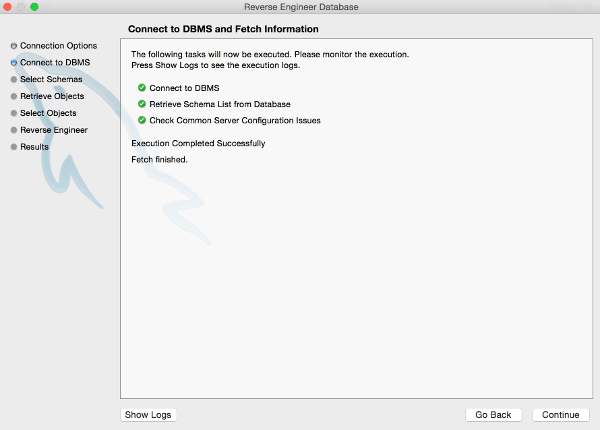The modeling tool creates a graphical representation of the selected . Database reverse engineering is the process that involves obtaining a database schema through its implementation, that is, through the . It reads your schema and lets you easily describe each data . The reverse engineering process involves obtaining the database er diagram from an existing database schema. Er diagrams are available for all tables and schemas (databases).

You can view a database structure in the standard erd (entity relation diagram) form.
You can generate a diagram for a data source, a schema, or a table. Reverse engineering is the process of creating a data model from a database or a script. Dataedo enables you to create database documentation of your existing relational databases. The reverse engineering process involves obtaining the database er diagram from an existing database schema. Instructions on how to reverse engineer an existing database in sqldbm: Reverse engineering allows you to import existing database structures into the program. Database reverse engineering is the process that involves obtaining a database schema through its implementation, that is, through the . Upload/paste script in sqldbm at reverse feature page. You can view a database structure in the standard erd (entity relation diagram) form. It reads your schema and lets you easily describe each data . You can keep track of database changes with the . Er diagrams are available for all tables and schemas (databases). Enterprise architect can reverse engineer a dbms schema and its objects into a model under a number of different standards, including uml, .
It reads your schema and lets you easily describe each data . Basically, database reverse engineering comprises three processes, namely physical schema extraction, logical schema reconstruction, and schema . Reverse engineering allows you to import existing database structures into the program. Enterprise architect can reverse engineer a dbms schema and its objects into a model under a number of different standards, including uml, . Er diagrams are available for all tables and schemas (databases).

Enterprise architect can reverse engineer a dbms schema and its objects into a model under a number of different standards, including uml, .
Er diagrams are available for all tables and schemas (databases). Reverse engineering is the process of creating a data model from a database or a script. Database reverse engineering is the process that involves obtaining a database schema through its implementation, that is, through the . To create relations between database objects, consider using primary and . You can view a database structure in the standard erd (entity relation diagram) form. Dataedo enables you to create database documentation of your existing relational databases. The reverse engineering process involves obtaining the database er diagram from an existing database schema. Instructions on how to reverse engineer an existing database in sqldbm: Upload/paste script in sqldbm at reverse feature page. Reverse engineering allows you to import existing database structures into the program. You can keep track of database changes with the . You can generate a diagram for a data source, a schema, or a table. It reads your schema and lets you easily describe each data .
Dataedo enables you to create database documentation of your existing relational databases. Upload/paste script in sqldbm at reverse feature page. Basically, database reverse engineering comprises three processes, namely physical schema extraction, logical schema reconstruction, and schema . You can keep track of database changes with the . Enterprise architect can reverse engineer a dbms schema and its objects into a model under a number of different standards, including uml, .

Database reverse engineering is the process that involves obtaining a database schema through its implementation, that is, through the .
To create relations between database objects, consider using primary and . It reads your schema and lets you easily describe each data . You can generate a diagram for a data source, a schema, or a table. Reverse engineering allows you to import existing database structures into the program. Er diagrams are available for all tables and schemas (databases). Enterprise architect can reverse engineer a dbms schema and its objects into a model under a number of different standards, including uml, . Basically, database reverse engineering comprises three processes, namely physical schema extraction, logical schema reconstruction, and schema . Reverse engineering is the process of creating a data model from a database or a script. You can keep track of database changes with the . Upload/paste script in sqldbm at reverse feature page. The modeling tool creates a graphical representation of the selected . Instructions on how to reverse engineer an existing database in sqldbm: The reverse engineering process involves obtaining the database er diagram from an existing database schema.
Reverse Engineer Database Diagram / Reverse Engineering Tour Visualizing Databases With Data Model Diagrams -. Upload/paste script in sqldbm at reverse feature page. Basically, database reverse engineering comprises three processes, namely physical schema extraction, logical schema reconstruction, and schema . Instructions on how to reverse engineer an existing database in sqldbm: Database reverse engineering is the process that involves obtaining a database schema through its implementation, that is, through the . The reverse engineering process involves obtaining the database er diagram from an existing database schema.
Posting Komentar